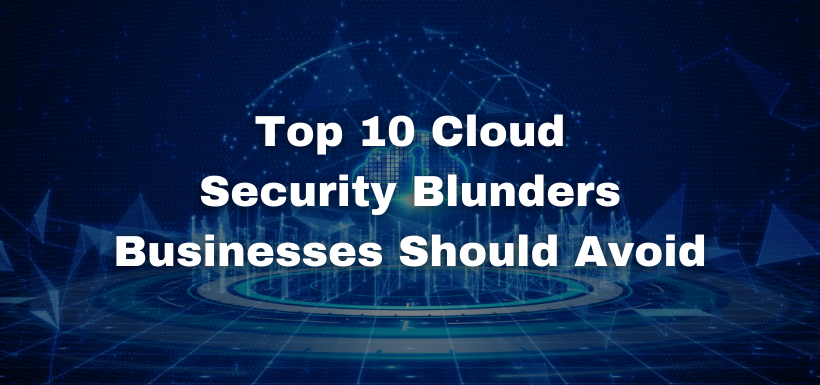March 2024 Newsletter
Businesses are increasingly relying on cloud computing to store, process, and manage their data. While the cloud offers numerous benefits such as scalability, flexibility, and cost-efficiency, it also introduces a new set of security challenges that businesses must address. From data breaches to compliance issues, the risks associated with cloud computing are real and can have serious consequences for businesses of all sizes.
Let’s discuss the top 10 security blunders that businesses need to be aware of when it comes to cloud security...
ONLINE SECURITY:
ADDRESSING THE DANGERS OF BROWSER EXTENSIONS
Browser extensions have become as common as mobile apps. People tend to download many and use few. These extensions offer users extra functionalities and customization options.
While browser extensions enhance the browsing experience, they also pose a danger which can mean significant risks to online security and privacy.
Key Risks Posed by Browser Extensions:
- Privacy Intrusions Many browser extensions request broad permissions. If abused, they can compromise user privacy. Some of these include accessing browsing history and monitoring keystrokes.
- Malicious Intent There are many extensions developed with genuine intentions. But some extensions harbor malicious code. This code can exploit users for financial gain or other malicious purposes.
- Outdated or Abandoned Extensions
Extensions that are no longer maintained or updated pose a significant security risk. Outdated extensions may have unresolved vulnerabilities.
- Phishing and Social Engineering Some malicious extensions engage in phishing attacks. These attacks can trick users into divulging sensitive information.
How to Mitigate the Risk
Best Practices for Browser Extension Security:
- Stick to official marketplaces.
- Review permissions carefully.
- Keep extensions updated.
- Limit the number of extensions you install.
- Use security software.
- Educate yourself.
- Report suspicious extensions.
- Regularly audit your extensions.
Catch of the Month: $22 Million Ransom Paid

This critical alert underscores your risk of a ransomware attack.
Leading blockchain analysts recently discovered a ransomware payment of $22 million in Bitcoin was transferred to an address connected to AlphV/Blackcat.
The group is responsible for a recent attack on one of UnitedHealthcare’s subsidiaries, Optum, within their Change Healthcare platform. AlphV/Blackcat is also the group behind the high-profile $100 Million ransomware attack on MGM Resorts International late last year.
This most recent attack on Change Healthcare also triggered a supply chain disruption as pharmacies across the US experienced a significant disruption in service, including outages and issues with patient insurance processing. In addition, although not specifically disclosed, this attack might mean that PII and PHI were gathered by the attackers as well.
Although Change Healthcare declined to give an official public statement about the event, there is a significant amount of evidence indicating that Change Healthcare sent this money as a ransom payment to the attackers.
Why does this matter to you?
Similar copycat attacks are very likely. It doesn’t matter the size of the company. It’s not just the big guys. Hackers are casting a wide net, and they’re coming after you and your clients and prospects.
Not only did AlphV/Blackcat collect hefty ransom payments that could fund future attacks, but they also demonstrated to other ransomware groups just how vulnerable even the most seemingly secure organizations can be. These vulnerabilities are very lucrative for these groups. The more they stand to gain financially, the more they will attack.
We have obtained specific indicators of compromise that are associated with an ongoing ransomware campaign. These indicators include malicious IP addresses, domain names, and file hashes.
The threat is real.
Immediate Actions:
- Raise Awareness: Notify your clients and/or prospects of this issue ASAP. Educate them and their entire organization on how to recognize potential threats.
- Immediate System Check-Ups: Conduct a thorough inspection of all systems and networks to detect any sign of compromise.
- Patch and Update: Download and install the most up-to-date versions of any OS, service, or application that could cause a vulnerability.
- Stay Vigilant: Keep an eye out for unusual activity on systems. You never know when an attack will occur.
Please address these items immediately as ransomware attacks are on the rise and you could be next!
Past Events
How to Elevate Team Productivity & Cybersecurity Using the Cloud
In this video, you'll learn:
- Actionable techniques to enhance team productivity, streamline tasks, and optimize workflow efficiency
- Essential tools and platforms that facilitate seamless collaboration among team members
- The importance of cybersecurity in the cloud and discover best practices to safeguard your data
How to Simplify Compliance & Turn Risks into Opportunities for Business Growth
In this video, you'll learn:
- About the evolving regulatory landscape in 2024
- How to build an easy, proactive compliance strategy
- How to transform compliance challenges into business opportunities
How to Make Your Non-Profit Budget Work in the Current Cybersecurity Climate
In this video, you'll learn:
- The current cyber risks and technology challenges non-profits face
- Non-profit budgeting strategies for cybersecurity and technology
-
Sustaining donor trust in the digital age through data protection and privacy






.png?width=1280&height=720&name=MVP%20How%20to%20Elevate%20Team%20Productivity%20%26%20Cybersecurity%20Using%20the%20Cloud%20(1).png)

